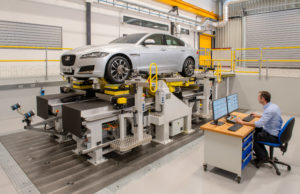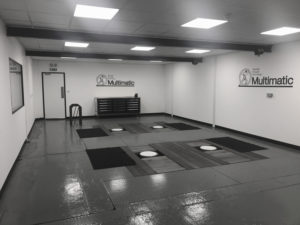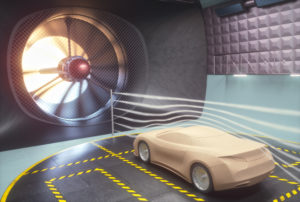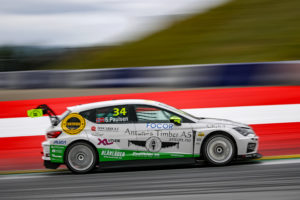R&D in the context of road cars and race cars is a very broad subject. Below are a few examples of testing methods that can be used to explore the characteristics of a vehicle that Pertechs has used throughout the years with success.
Kinematics & Compliance Rigg
Testing the suspension characteristics (and to some extent also a few complete vehicle items) in a K&C rigg is a vital step in car development. The data retrieved from such test can be used both for direct understanding of the weak areas of the car that needs further attention to improve its behaviour and also to feed into simulation packages such as for example Adams/Car or Lap Time Simulation software’s to learn how those characteristics transform into true vehicle behaviour and lap times on a particular track. Pertechs has used K&C testing for many years and knows how to plan, execute and post process the data to gain as much as possible from a test like this.

4-Post Rigg
The learnings and experiences gained from testing a car at a 4-post rig (or 7-post rig) are extremely helpful in moving forward in terms of damper configurations and settings in particular but also regarding ride springs, antiroll bars and tires. As with all kinds of rig testing, the available time is normally limited and therefor a well thought out test plan before the test as well as adaptive thinking within the test governs a successful test. Pertechs has managed numerous tests like this and can take full responsibility throughout the whole process to maximise the effect of the available time.

Body Torsional Stiffness Testing
Testing the car’s torsional stiffness is really important if you want to optimise its torsional strength vs weight. It is also very educational as you can validate the contribution in stiffness from various elements and features around the car and what is important and not within the manufacturing process. You can also learn if your car has a particular weak area that needs attention to enhance its total stiffness.
Pertechs has developed both the physical rig and the routine used for this testing method and this experience governs that we can support you with all what is needed to complete successful tests as well.
Wind Tunnel Aero Testing
The aerodynamic performance contribution of a vehicle in general and a race car in particular plays a very important role in the overall performance and is therefore of great interest if you want to get ahead of your competition. Testing the aerodynamics in a wind tunnel can be a very efficient way of exploring the performance and behaviour of the vehicle. Pertechs has managed numerous wind tunnel sessions and can thereby provide your team with a successful wind tunnel session in terms of planning, execution, data post processing and reporting. This is vital as wind tunnel time is normally very exclusive and therefore you need to be efficient with the time available.

Straight Line Aero Testing
If a wind tunnel is not available, a straight line aero test can provide very good aero data of your car. In fact, in many circumstances, a straight line aero test is preferred compared to a wind tunnel test as the data that you retrieve is the true performance of your vehicle without doubt. A test like this is very often a very cost effective way of extracting additional performance from your vehicle. Partly it comes from just understanding the behaviour of your vehicle and partly it comes from finding new solutions that provide additional aero performance, either from reduced drag or increased down force.
Pertechs has successfully executed tests like this and can provide the complete process including planning execution and data processing/reporting as well as assisting in equipping the vehicle with the necessary measuring equipment.
The results of such test will be:

If one of more of the above mentioned specific tests are of interest for you, contact Pertechs for further discussions about how we can support you with this.
